A comprehensive guide to contact and call center training

Customer Support Manager - Tier 1
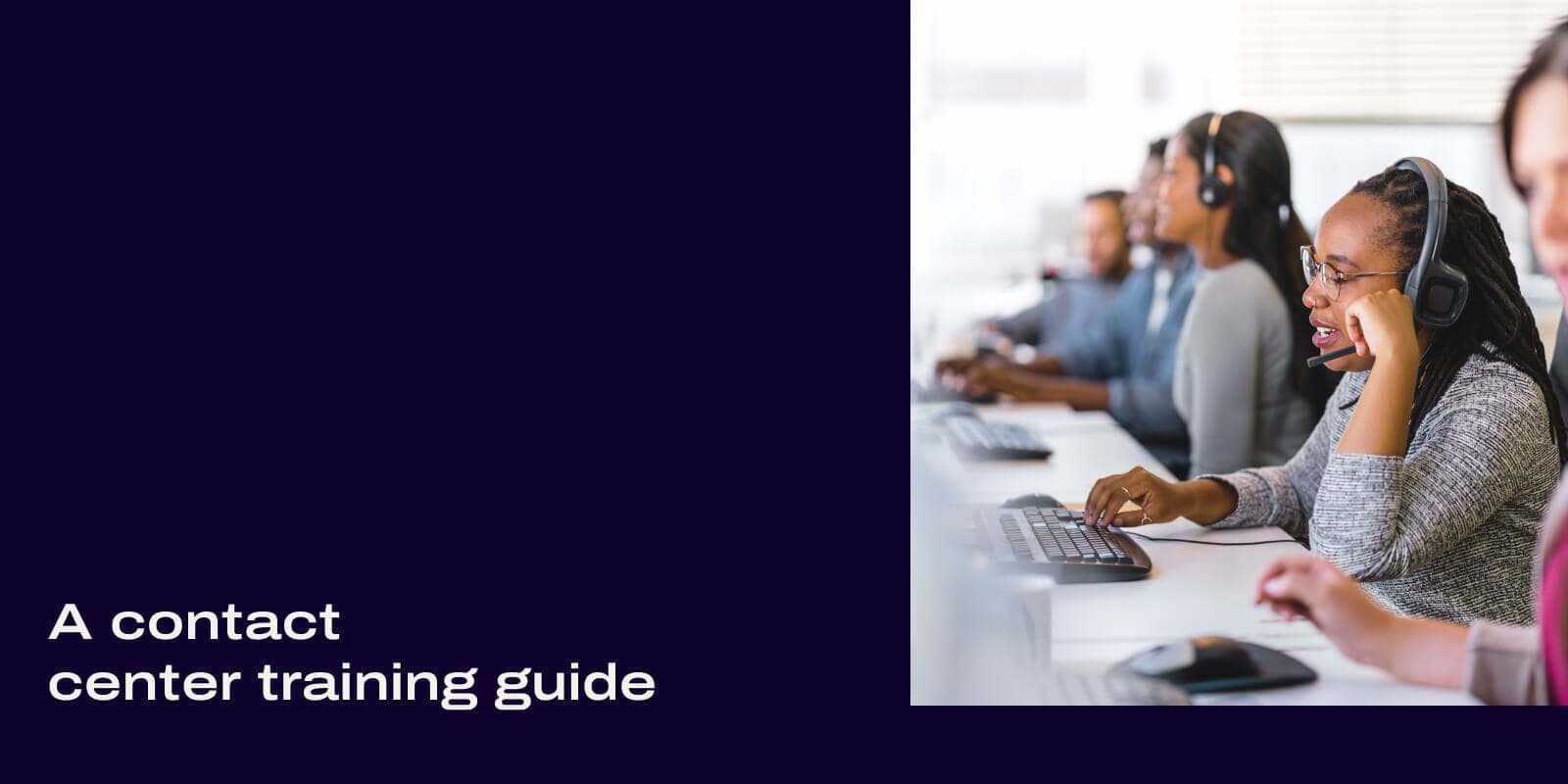
Tags
Share
It’s no secret that many contact centers experience high agent turnover. A lot of folks think that’s because the job is unskilled and unrewarding. But it doesn’t have to be that way.
By giving your agents the right tools to do their jobs well, you can help your contact center teams be more engaged, more productive—and much more likely to hang around. One of the most important tools?
Excellent training from their managers, who need to keep everyone motivated and find solutions when things go wrong.
As a Support Team Lead, I run a large contact center team. In this post, I’ll share my insights and give you some tips on how to train agents for success.
Evolving from a call center to contact center
There’s a world of difference between call centers and contact centers. Call centers handle phone calls, whereas contact centers handle customer interactions on multiple channels.
Yes, there’s still a small portion of businesses (usually small or local businesses) that only communicate with customers over the phone. But what if your business has a live chat option or Contact Us form on your website, or an email address for customers (or prospects) to get in touch through? These are all different communication channels that you’d need someone to monitor daily!
That’s why many companies have started moving their call center operations toward a contact center model—so that they can provide a better customer experience by being on the channels that their customers want to be on. Yes, it’s a bit more work than just having someone monitor the phones, but if your customers are like most people, they’re expecting fast response times on every channel (social media, email, and so on) they’re reaching out to you on.
And as we’ll see later, if you have a good training program for agents, this evolution from call center to contact center can actually be a pretty painless process.
The importance of proper and effective contact center training
In case you’re not sold on why good training is so important for a contact center, here are a few reasons why. I’ll walk you through our training tools in more detail in the next section, which we ourselves use to train contact center and call center agents.
It motivates career growth
I’ve found that giving agents thoughtful and regularly updated training really helps their motivation and ambition. It’s so rewarding to learn new skills, achieve milestones, and know that you’re hitting your SLAs consistently.
At Dialpad, one of our goals is to build a culture of continuous development with ongoing training—yes, even for high-performing agents. (This is especially important for industry-specific knowledge and companies with strict compliance protocols.)
It reduces turnover rate
High turnover of call center staff is a very common challenge that you’ll want to prevent, because it’s much easier than trying to cure it after the fact. If people keep leaving, you’ll end up spending half your time onboarding new hires! Not the best use of time. It’s better to retain a close-knit team that communicates well.
Efficient training and contact center workforce management can definitely increase agent retention, which translates into more productive teams and happy customers.
It increases profit margins
Ultimately, a good call center training program can boost your bottom line. Well-trained agents are more productive and efficient, which lowers costs. Plus they tend to develop stronger relationships, which breeds customer satisfaction and retention (and makes it easier to cross-sell and upsell later on).
10 contact center / call center training tips every manager should know
Now let’s check out the techniques and tools you’ll need to deliver excellent training. Most of these can be used across both contact center and call center training.
1. Have clear goals and objectives
Having clear and accessible objectives is hugely important—not only for supervisors but also for agents. If agents don’t understand what they’re being asked to achieve, how can they achieve it? Always encourage them to ask if they’re not sure.
Everyone should know what’s expected, and why. Instead of just telling them what to do, help them understand the importance for the business as a whole.
Contact center goals often include KPIs (key performance indicators) like speed-to-answer and missed calls. They may make perfect sense to you or to someone who’s a contact center veteran, but for many new hires, the reasons behind why you track certain metrics aren’t always obvious. Help them understand!
2. Leverage analytics and data
And on that note, you then need a way to track and measure those metrics!
For many contact centers, this is one of the biggest and hardest-to-solve challenges. Getting access to the data is often difficult—depending on your contact center software, you may need to reach out to your vendor’s support team every time to get the CSV files or analytics reports you need.
One of the perks of using Dialpad's cloud contact center platform is that we can easily access our dashboard and heatmaps to check our service levels and apply this to staffing. (We’re operational 24/7, so we have to know if there are enough agents to cover busy times!)
For example, our supervisors get alerts if our service levels ever drop below a certain threshold:
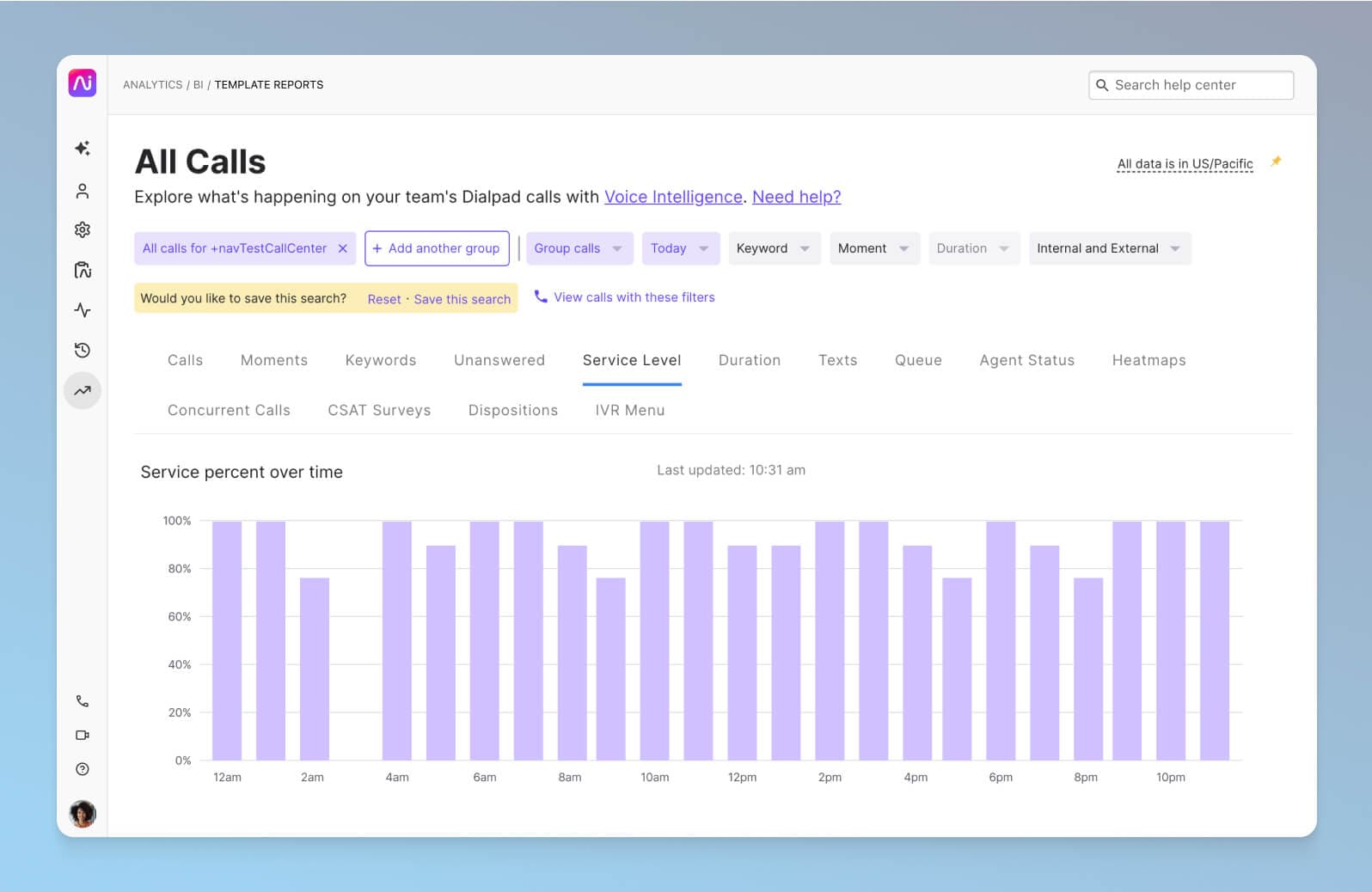
And here’s the really unique thing: we can also pull analytics on our Custom Moments to see how often certain words are triggered. For example, if I wanted to see why customers have been asking for refunds lately, I can create a Custom Moment in Dialpad to track every time the word “refund” or “money back” is said on a call:
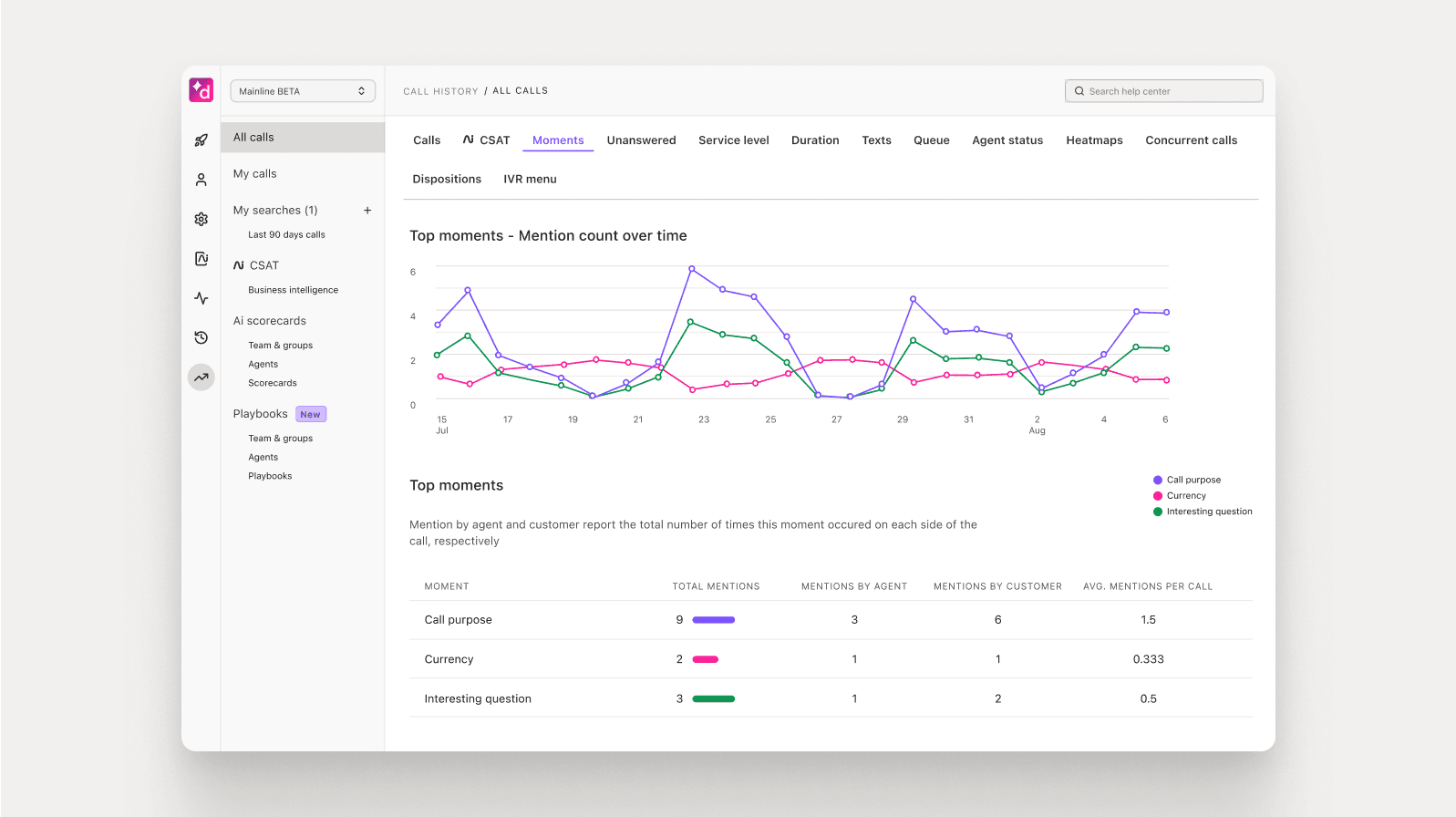
I can easily track how frequently this comes up on calls over a period of time, and if I notice that there’s a spike, I can dig into those call recordings to understand the context better—which allows me to create more training materials to help our agents on these conversations.
👉 Dialpad tip:
This sounds pretty incredible, but it’s because Dialpad Ai is so accurate at transcribing phone conversations. Not only can it transcribe calls, that also means it can pick up on any keyword phrases that you want, to help with training and development in your contact center.
Analytics also enables us to give constant feedback to agents. We can easily show them how their metrics have fluctuated over a certain period of time, and discuss how they could improve.
3. Provide good technical onboarding
If you’re like us, you may be using other apps and tools in addition to your contact center software. That usually means extra training for your agents, but if you can try to make sure these tools are all integrated with each other, you can at least streamline workflows so that your agents don’t have to copy and paste data back and forth constantly.
For example, Dialpad integrates with CRM tools like Salesforce, HubSpot, and Zendesk to automatically log activities and even let agents make phone calls through Dialpad—directly within those platforms:
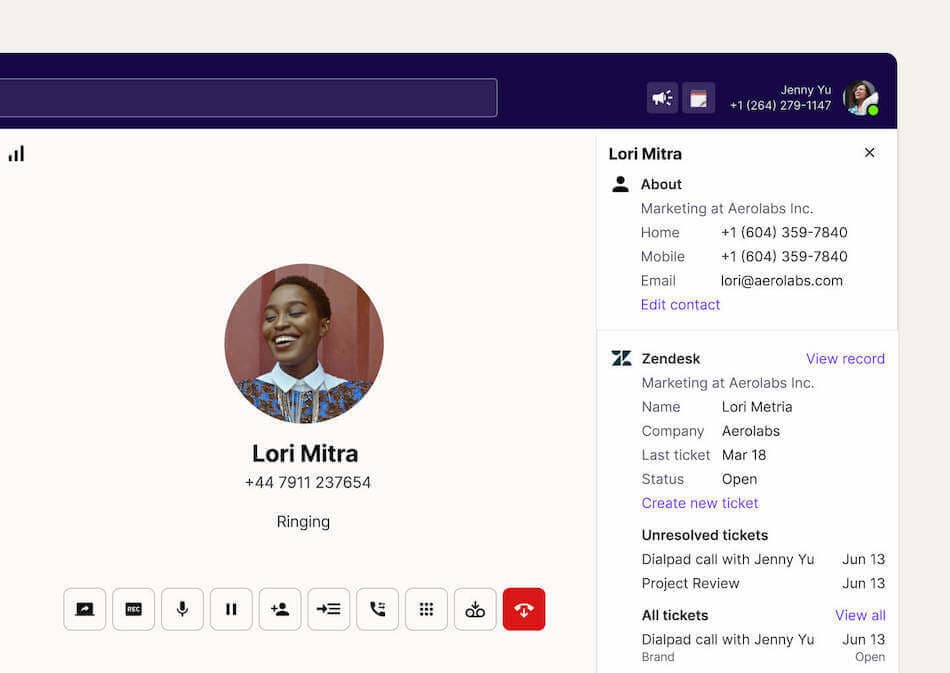
Before you put them on the front line, new hires need to know how to use your contact center technology, whether it’s just a phone system or your CRM-integrated contact center platform. Customers don’t want to hear, “Bear with me while I find your details” or “I need a supervisor to process your payment.”
Sitting side-by-side with an agent is ideal, but it’s harder with remote work. In this case you could run online training via video conferencing. (Dialpad has screen sharing, which allows me to follow along on a new agent’s screen.)
4. Don’t try to coach every customer conversation personally—use technology to help you train at scale
There are also many contact center coaching tools we use to train agents at scale. What I mean by this is that we have many more agents than we do supervisors—and not every supervisor can personally coach every single call with every single agent. So what can we do to make sure agents are getting the knowledge they need to handle customer conversations?
I mentioned Dialpad Ai earlier, and one great thing it can do is live sentiment analysis. As it transcribes calls in real time, it can also pick up on positive or negative words to show me whether my agents’ calls are going well—or not so well:
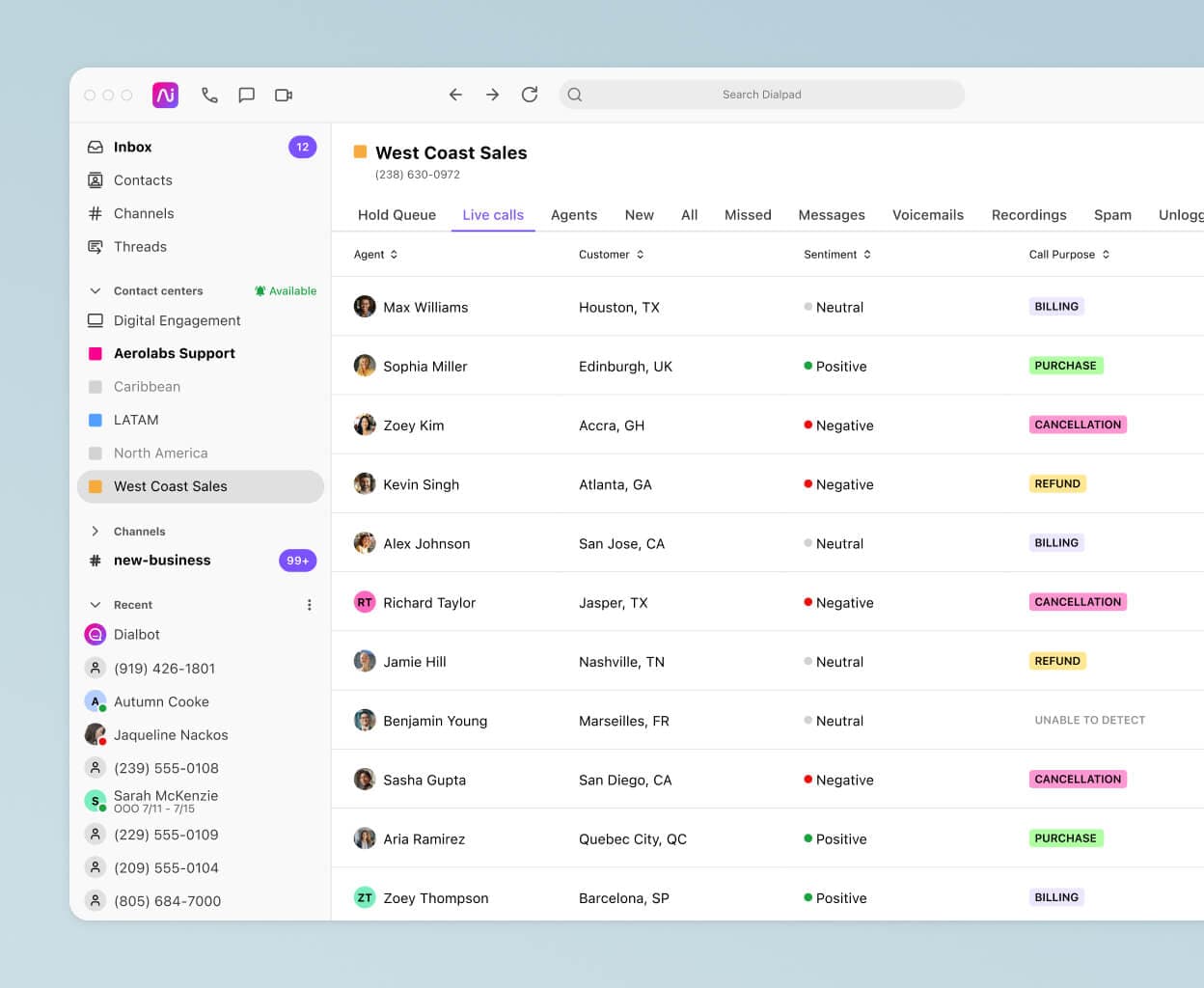
If I notice that something is wrong, I can open up the real-time transcript to get more context, and then hop on the call if needed.
Beyond this, I can also create Real-time Assist (RTA) cards to pop up important information for agents when tricky topics come up in conversations. For example, if I notice that many customers have been asking questions about how to port a number over, I can create an RTA card with notes on how to talk about our porting process:
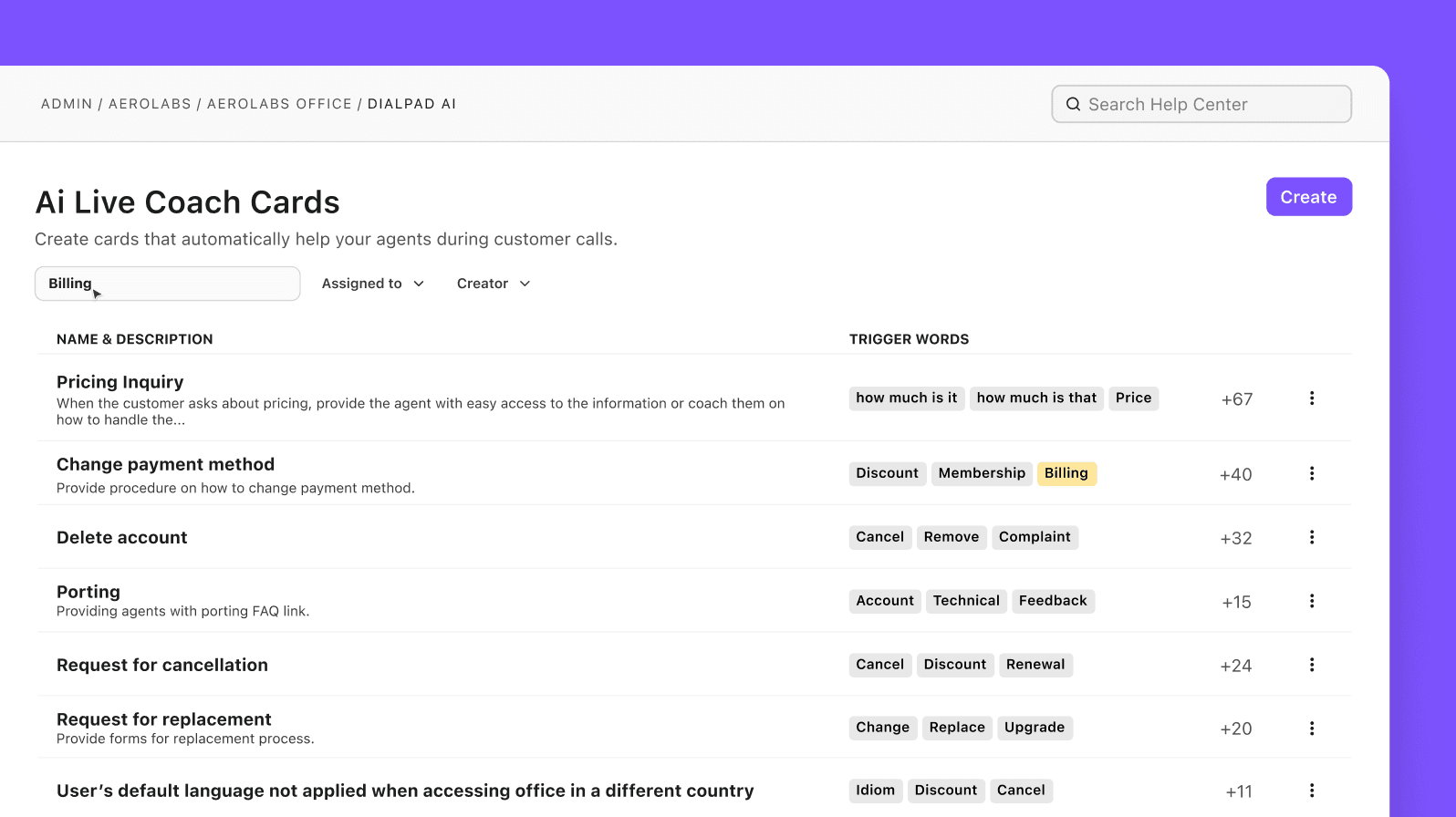
Of course, it’s not possible for supervisors to listen to every single call, but we still need to provide meaningful feedback to our agents as often as we can. That’s one way Dialpad Ai Scorecards helps customer service teams scale operations.
With Ai Scorecards, supervisors and admins can create an objective scoring criteria across all customer calls. As the agent behavior is observed by Dialpad Ai, it's automatically checked off—so when the supervisor reviews the call later, they can easily see whether the agent is doing what they are supposed to:
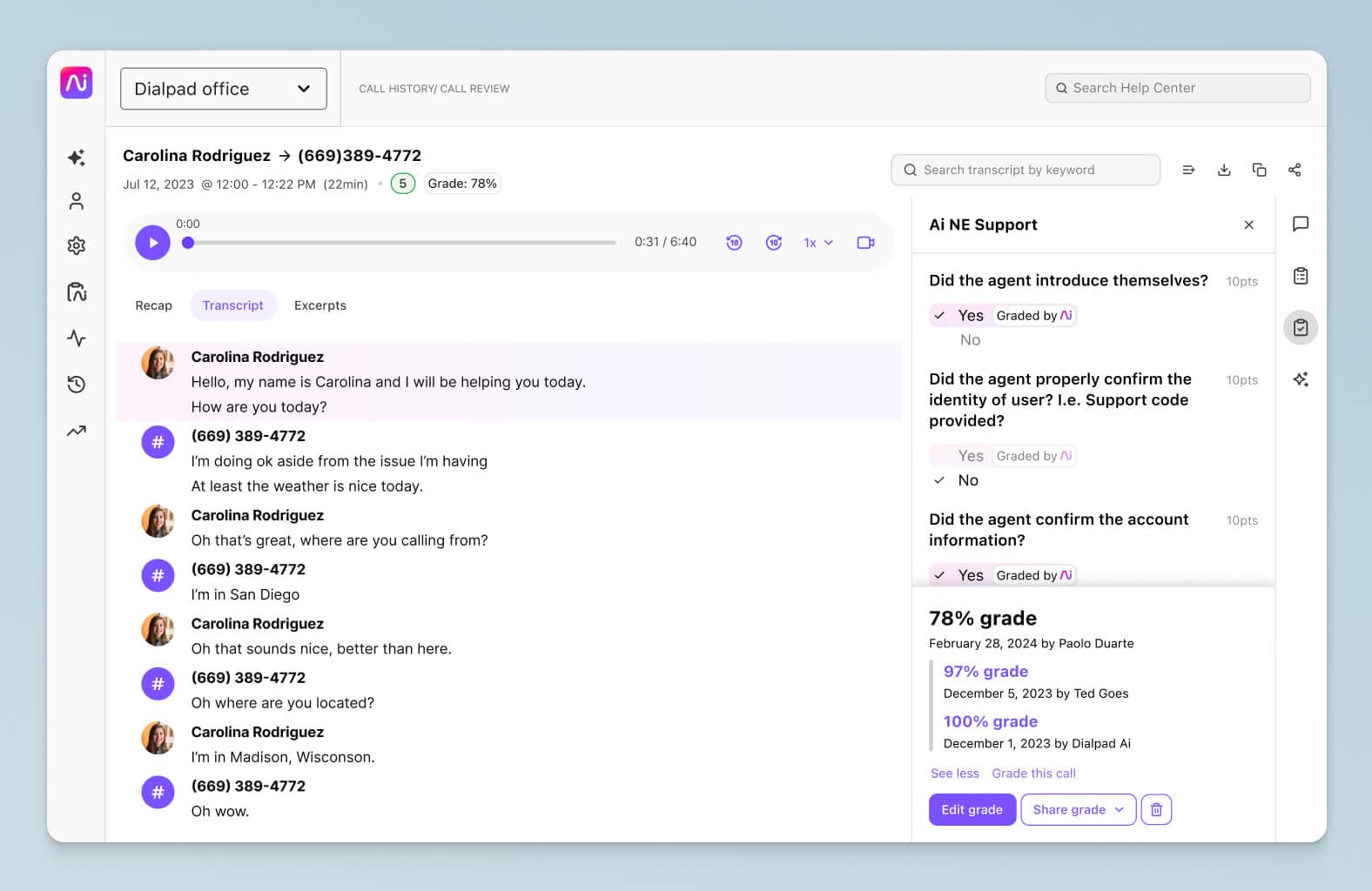
This makes it easy for supervisors to grade calls without listening to an entire call recording or reading a transcript, and gives them the ability to evaluate far more calls in far less time. In turn, this means a higher volume of effective coaching for contact center staff.
This is what we call training at scale—agents can learn on the job while still getting the information they need to handle conversations without having a supervisor accompany them on every call. It helps them build confidence (and lets us take off the training wheels) more quickly.
And of course, as well as knowledge of products and tools, agents need soft skills like active listening, critical thinking, and making customers feel valued.
Contrary to popular belief, soft skills can be taught! Include soft skills training so that agents communicate better with customers and each other.
5. Focus on continuous (and customized) training
Many folks have a tendency to focus only on initial training, but ongoing training is just as important! In our contact center, there’s always something new to learn—not to mention customer behaviors are constantly changing. We assess agent performance with Dialpad’s analytics and monitoring tools, which I mentioned earlier, and provide more customized training sessions if needed.
Call recordings are essential for evaluating contact center management and performance, and for use in future training courses. This is a big one for me as we often revisit our onboarding and call center agent training materials. What’s neat is that we can create “playlists” of good (or bad, I guess) calls and share with agents so that they can listen to these calls and learn on their own time:
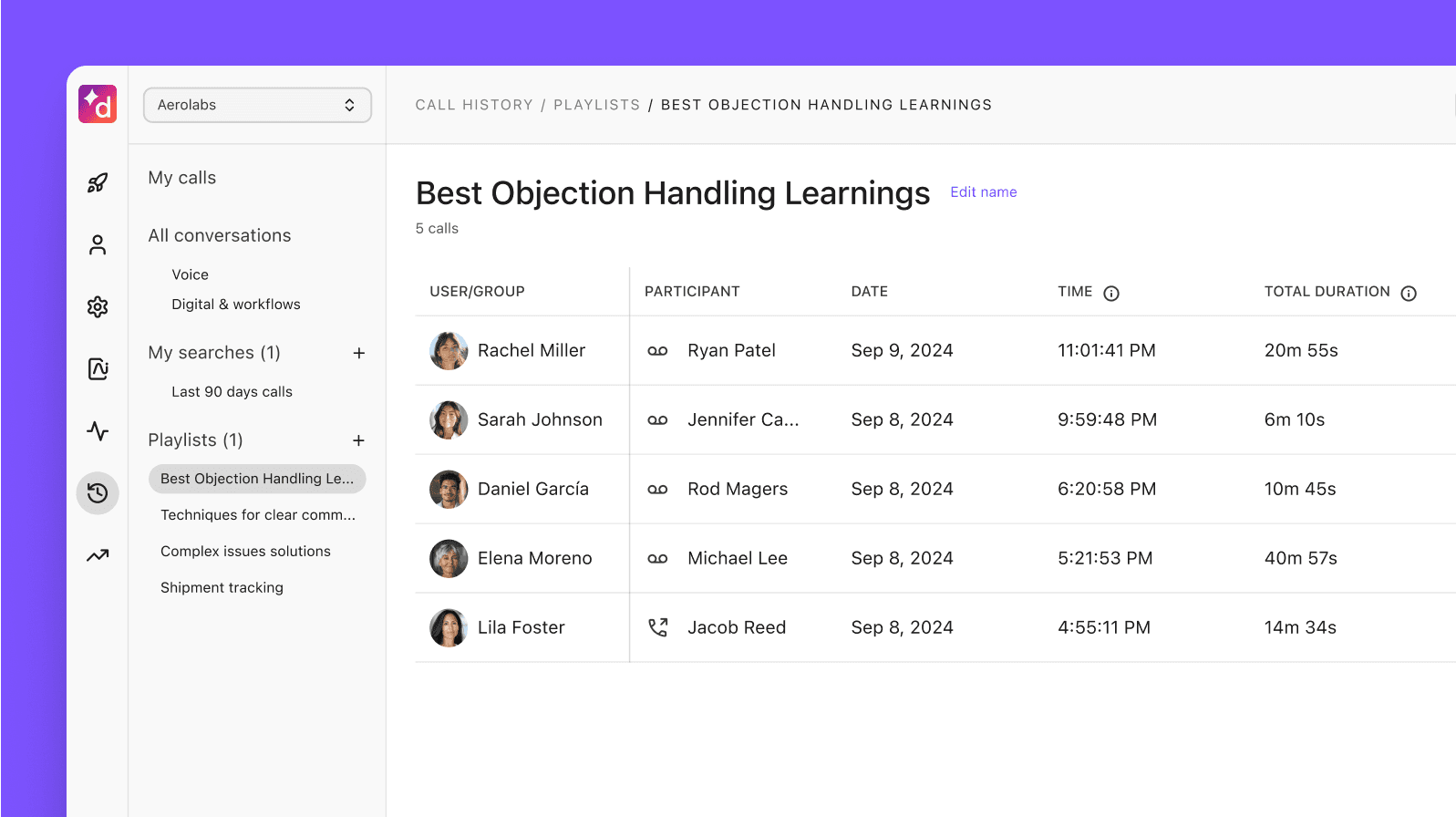
6. Deploy a buddy system
It’s great for agents to learn from each other (and not just because it gives managers a break!). As well as different skill sets, each agent brings unique insights from the calls they’ve taken and the questions they’ve handled.
One idea is to pair up agents in a buddy system. This informal training method is a great way to help new agents feel at home, and they’ll always have someone to turn to with questions or issues.
You could match new hires with top performers or call center supervisors, with a structured introduction to contact center life. It’s a bit like mentoring or shadow-learning—employees learn the ropes working side-by-side (virtually) with another agent.
7. Provide constant, evidence-backed feedback
Open communication means creating a safe space where everyone feels comfortable with asking questions, airing issues, and making suggestions. It also requires managers setting clear expectations so that the team is aware of its goals.
Basically, you should develop a culture of mutual understanding and respect. Check in with your team regularly to ensure all communication lines are open, especially if you’re managing remote workers.
This is why I had analytics up at the top of this list. Having the data to back up your constructive criticism is essential if you want your agents to buy what you’re saying about their performance and understand that it’s not personal—you’re being objective.
8. Create a knowledge base
A comprehensive knowledge base is highly useful for agents, as they can double-check things without having to ask a supervisor. It might include training materials, info on brand identity, and details of your products or services. This all helps agents become better informed about the company.
It’s a good idea to ask your agents what they’d like to learn more about, and fill in any gaps in the database. After all, they’re the ones who need all the answers at their fingertips!
You can also use the knowledge base to share best practices of high-performing agents, such as recordings of successful interactions—perfect for ongoing training.
This is another example of how to “train at scale.” Even though creating the knowledge base takes more work up front, it allows you to be more hands off later since agents can find answers on their own.
9. Incentivize milestones
Everyone loves an incentive. It makes sense to reward your team when they’ve hit a target, or gone above and beyond. This doesn’t necessarily have to be financial—it could just be a treat like a box of treats or gift card.
You could offer varying levels of incentive, such as individual and team prizes for monthly or quarterly targets and employment anniversary gifts. Other ideas include public “shout-outs” for delighting customers, and peer-to-peer recognition for helping out.
I’ve found that this creates a positive atmosphere, which actually increases employee engagement and productivity. It’s also useful for agents who work from home, as it helps them feel included. Don’t forget to add gamification to make the workplace more fun!
10. Update your training regularly
Training is fluid. It’s never complete—both managers and agents are always learning. What with updated systems and new technology, last year’s training courses may no longer be as relevant next year.
Whether you have in-house teams or at-home agents, try to set yourself a yearly reminder to check if your online courses or training materials for agents are still effective. If you’re noticing recurring issues or gaps in service, it’s not always the agent at fault. It might be the training!
That's why Dialpad's analytics are so useful for us. We can easily track if certain "problem" areas or topics are coming up frequently and adjust our training to help agents speak to those confidently:
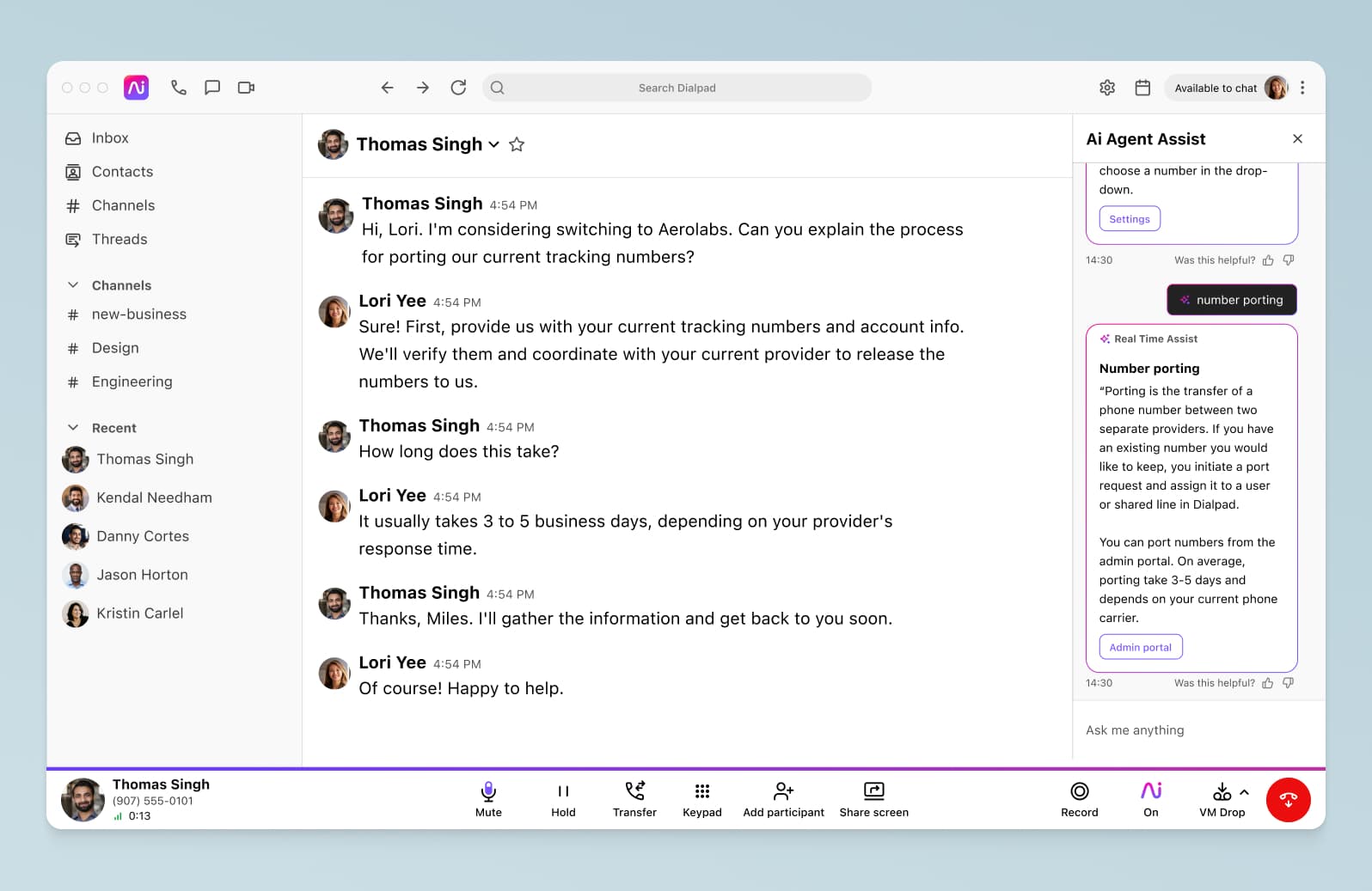
Bringing the tips together to build a call center training program
As a CX leader, having a training program in place to help your customer service team stay up-to-date on the latest technology and customer service best practices is essential for success.
With some of the highest employee turnover / attrition rates across different industries, having a robust and scalable contact center training program is essential. Otherwise, your supervisors and training managers will be wasting time unnecessarily trying to do this from scratch every time.
Below, let's look at a few steps for how to build a contact center training program that effectively reduces customer complaints, increases customer satisfaction, and maximizes employee effectiveness.
Call center training program outline: 5 key components
First, it’s important to determine what type of training is necessary for your team—from basic product knowledge to advanced customer service skills—and how often the training should take place.
Once you have an idea of what type of training is needed, you must decide how best to deliver it: in-person workshops, online courses or a combination of both? Here, it's important to consider how you'll measure success and track progress throughout the duration of the program.
The overall
goal
(s) that you want to achieve. This should include specific objectives such as increasing customer satisfaction, reducing wait times, improving
, or achieving other performance metrics.
Which
topics
will be included in the training curriculum. This should include all relevant topics related to your customer service strategy, such as product information, soft skills, troubleshooting methods,
steps, process improvements and so on.
How long
each training session should last and
how often
they should occur. Depending on the complexity of the topics being taught and size of your team it could range from one day of intensive instruction up to several weeks or months with multiple sessions spaced out over time. Ideally, training is part of an ongoing program. (Industry trends change, regulations get updated, and your products and services are probably constantly evolving!)
The best
training methods
for achieving those goals. Contact center managers used to have to manually review calls and coach agents one by one. Today, with
tools, a lot of this work can be automated, which not only helps agents get more consistent and regular coaching, but also lightens the load on supervisors too.
Finally, make sure that your call center training program includes
regular
assessments
throughout its duration so that any areas where improvement is needed can be identified quickly before they become bigger issues later on down the line. (You may also want to give agents and supervisors incentives for completing their training successfully, like bonuses or recognition awards in order to motivate them further towards excellence within their role at your organization.)
Ready to hone your contact and call center training techniques?
Whether you’re upgrading from a call center to contact center, or your training program just needs a boost, Dialpad Contact Center has a variety of features designed to help supervisors teach agents more effectively (and efficiently).
As well as providing unified communications to keep your team members in sync no matter where they are, Dialpad covers your training needs with features like call monitoring, Dialpad Ai, and Custom Moments—all of which are built to help you with ongoing assessment and training.
Need contact or call center training software that’ll help you coach + train agents?
Book a product demo of Dialpad to learn more, or take a self-guided interactive tour of the app on your own first!
